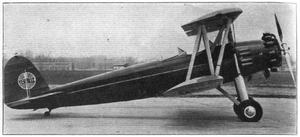The Verville Sport Trainer AT is a two-seat tandem biplane designed by Alfred V. Verville as a civilian version of the YPT-10 primary trainer, intended to appeal to the wealthy private owner.[1]
| Verville Sport Trainer AT | |
|---|---|

| |
| Role | military trainer & civilian luxury plane |
| Manufacturer | Verville Aircraft Company |
| Designer | Alfred V. Verville |
| First flight | 1930 |
| Primary user | private & USAAC |
| Number built | 11 (sportsman), 4 (YPT, military) |
The White Aircraft Company bought the rights to the AT in 1939.[2][3]
Civilian version
editThe Sportsman, as it was also known,[4][5] offered excellent flight characteristics and good stability, due in part to the design of the lower wing. With leather trim, battery with starter, and navigation lights, the Sport Trainer sold for $5,250. There were 10 manufactured. The owner of serial number one was Eugene Francis May.[6]
One AT was built for NACA testing in 1930, and was designated the AT-4. It had modified wide landing gear with added fittings for pontoons, which may or may not have been used. The colors were a blue fuselage, silver wings, yellow stripe. Special equipment included: EDO pontoon fittings with structural bearing, steel interplane struts.[7] On 31 January 1931, test pilot Lou Meister bailed out of this plane after entering an unrecoverable spin. He died when his parachute did not fully deploy after bailing out.[8]
One AT was modified in 1931 for Lycoming Manufacturing Company of Williamsport, Pennsylvania. It was designated the LT Sportsman. It was fitted with a 210 hp Lycoming R-680.
Kenneth Parker, the son of George Safford Parker, founder of Parker Pen Company owned an AT.
Military version - trainer
editThe USAAC purchased 4 YPT-10's and tested with 5 different engine versions resulting in YPT-10 thru YPT-10D designations. It had a 165 hp engine and could produce top speed of 120 mph, which was not faster than other aircraft of that era, but was more than adequate for the flight training purposes of the Army.
Specifications
editGeneral characteristics
- Capacity: 2
- Length: 24 ft 3 in (7.39 m)
- Wingspan: 31 ft (9.4 m)
- Height: 8 ft 9 in (2.67 m)
- Empty weight: 1,562 lb (709 kg)
- Gross weight: 2,243 lb (1,017 kg)
- Powerplant: 1 × Continental A70 7-cyl air-cooled radial piston engine , 165 hp (123 kW)
Performance
- Maximum speed: 115 mph (185 km/h, 100 kn)
- Endurance: 3 hours 30 minutes
- Other specs
- Heywood air starter
- dual A.P.C. brakes[9]
See also
editReferences
edit- ^ Willey, Scott, Verville Sport Trainer AT, Garber Facility Virtual Tour, Aviation History Online Museum
- ^ "Abandoned & Little-Known Airfields: New York State: Rochester area". Airfields-freeman.com. Archived from the original on 2014-05-17. Retrieved 2014-05-16.
- ^ "American airplanes: Wh - Wy". Aerofiles.com. Retrieved 2014-05-16.
- ^ Joseph P Juptner's US Civil Aircraft, Volume 3 (Page 193-195). ISBN 978-0830643684
- ^ Joseph P Juptner's US Civil Aircraft, Volume 4 (Pages 83-86). ISBN 978-0830643691
- ^ The Early Years Archived 2016-03-03 at the Wayback Machine, Gene May Test Pilot Extraordinaire!, 2009 Carroll's Creations
- ^ Verville, Verville-Packard, Verville-Sperry, Aerofiles, 4/17/09
- ^ "Skyways". Skyways (60): 30. October 2001.
- ^ "1930 | 1014 | Flight Archive". Flightglobal.com. 1930-08-29. Retrieved 2014-05-16.